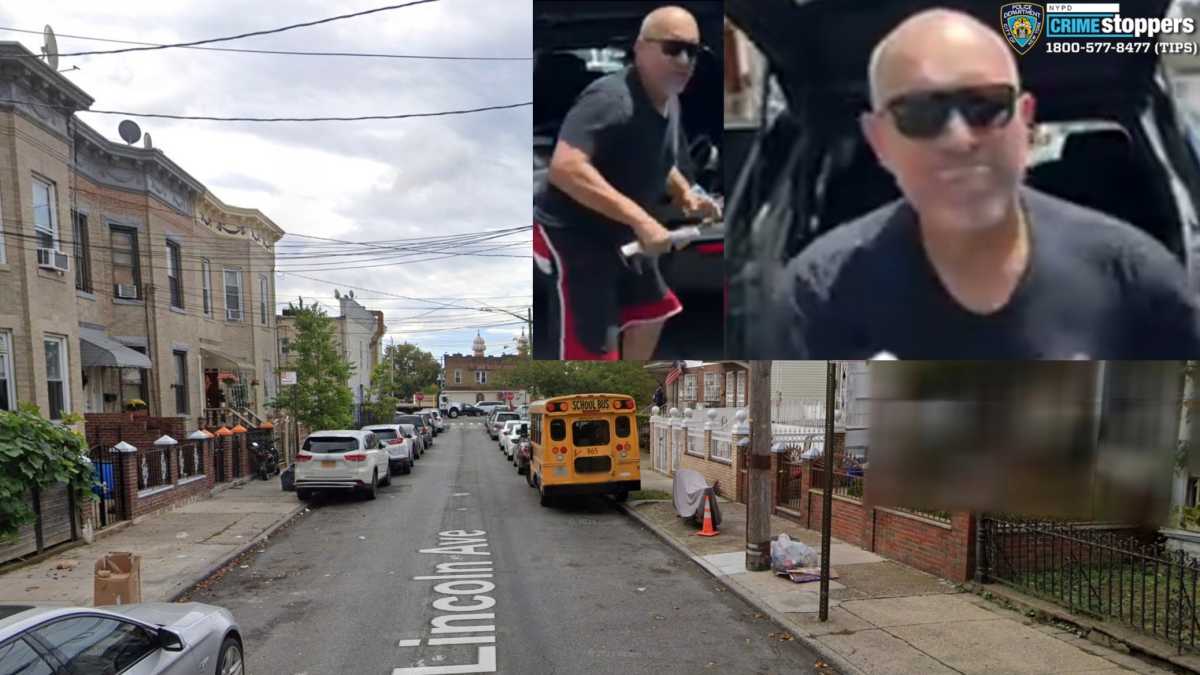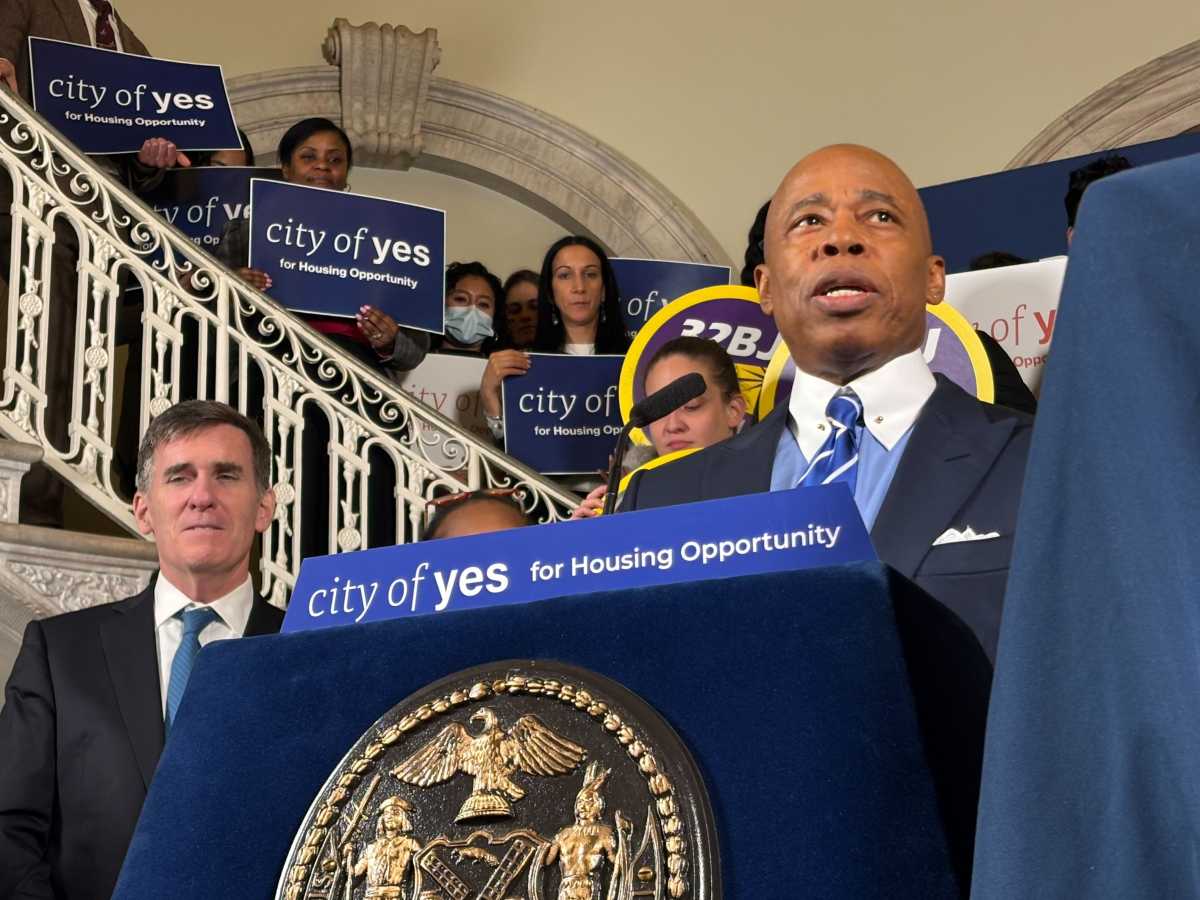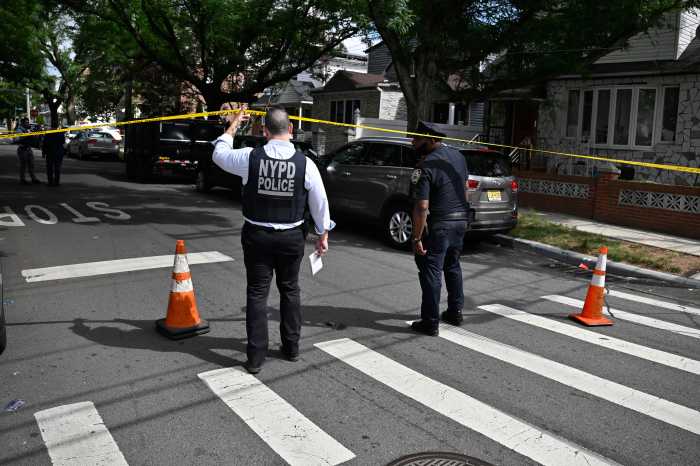A group of exiled Brooklyn Heights residents is seething now that their
former neighborhood association is trying to preserve the former candy
factory from which they were evicted over the past year.
The six-story building at 20 Henry St., known as the Candy Factory for
a previous incarnation as the Peaks Mason Mints factory, was until December
a complex of 42 artist lofts. It now stands vacant for the first time
in 30 years.
Meanwhile, the development company that bought the building after a previous
owner opted out of the Mitchell-Lama housing subsidy program, has plans
to build an adjacent high-rise on what is now an open courtyard to the
building, at the corner of Poplar Street.
The Brooklyn Heights Association (BHA) testified before the city landmarks
Preservation Commission last month that construction of the new building
would threaten the character of the historic district, the city’s
first.
But many of the former inhabitants of the Candy Factory, who were evicted
as their leases expired and are now struggling to situate themselves outside
of the high-priced neighborhood, say they might not have been forced out
if the powerful BHA had been as vigilant about their constituents as they
are about the neighborhood’s buildings.
“We worked very hard to try to get something concrete out of them,”
said Anita Karl, a graphic designer who has lived in Crown Heights since
being evicted from the Candy Factory last April. “Here they’re
all worried about the courtyard but we couldn’t get them interested
even slightly in the plight we were facing.”
Early this year, the rent-controlled units at the corner of Poplar and
Henry streets still had a few tenants. But the final eviction last month,
of musician and writer Cedric Turner, who is currently homeless, left
the building vacant and facing redevelopment. (Read
Candy Factory story.)
Like many tenants, Karl and Turner said they were promised by both city
and borough officials that they would be relocated. But the help never
came, they said.
Turner said he shied away from the court battles waged by the final tenants.
“Protesting is for people who have time to protest,” he said.
“They could’ve at least let him stay,” said BHA Executive
Director Judy Stanton. “They can’t do anything anyway until
they have permission from Landmarks.”
“It’s kind of creepy,” said Stanton, who said she’d
passed the building recently and noticed the lights of one unit still
on.
Former tenant Gary Minda, an attorney now living in Cobble Hill, agreed.
“That building is just sitting there, it’s not going anywhere.
They could’ve let us stay until the spring,” said Minda, who
added that the BHA could have allied with the tenants — many of whom,
like Minda, could afford increased rent and had offered to pay market-rate
for their units, but were pushed out just the same.
“That’s what was remarkable,” said Minda. “I got the
feeling they were just as happy if the middle-class housing got moved
out,” he said. “They’re more concerned about the aesthetics
than the diversity of the community.”
Minda added that he had appealed to housing court and the developers to
let him stay, for the sake of keeping his 5-year-old daughter in school
at PS 8, just down Middagh Street from 20 Henry St.
“I think there were many people — at least 10 families —
that would’ve stayed,” he said.
Menacham Kastner, a lawyer for the property owners, said renting at market
rate “was never a discussion. It was never an issue on the eviction.”
Under the Mitchell-Lama housing subsidy program developers were offered
tax incentives and low-interest loans in exchange for keeping the developments
as low-income housing for at least 20 years.
Edward Penson bought the building from the city in the mid-1970s for $55,000
on the condition that he offer it to middle-income tenants, especially
artists. After 20 years he had the right to buy out of the program by
paying off the $2 million mortgage to the city Department of Housing Preservation
and Development and the city Housing Development Corporation.
He exercised that right in June 2003, after a four-year battle with the
tenants, many of them artists, who sought to keep the building under the
rent subsidies. Penson sold the building to Praedium Management for $6.6
million a few months later.
Immediately, Praedium commenced eviction proceedings against tenants as
their leases expired and negotiated to cover their moving costs. The highest
paid was $5,000, according to interviews with long-time residents.
Stanton said the BHA bowed out of trying to fight because the evictions
were inevitable.
“I can’t think of a time when we interceded or intervened between
private landlords and tenants,” said Stanton, though she said she
personally sympathized with their plight. Although a BHA representative
who had experience with the city policies on housing regulations had acted
as a representative earlier in the tenants’ legal struggles, by last
year’s evictions, Stanton said, “We were out of that picture
entirely, and elected officials were brought in.”
Beyond that, she said, they hadn’t heard about subsequent problems,
such as Minda’s pushing to stay at market rent in the building.
“We weren’t pulled into that, and I don’t know anybody
that was pulled into that,” Stanton said.
Neddi Heller, an artist and teacher who moved into the building in 1987,
was a member of the BHA during the eviction process. She said it wasn’t
a matter of the BHA not knowing — it was that they did not care.
“We were second-class citizens compared to the way we should’ve
been treated,” said Heller, who said that since she moved into the
building in 1987, she had become an active community member, was involved
with preserving the Harry Chapin Playground on Middagh Street at Columbia
Heights and joined the Brooklyn Historical Society.
“I went to the BHA and said, ‘Can you do more for us?’”
Heller recalled. “They really weren’t supportive of us and could’ve
been a force to say, ‘Preserve this, and keep this part of the community.’”
As a result, many of the remaining Candy Factory residents say they suffered
unlocked front doors, sporadic heating, rodent infestation and dirty hallways
as the super and landlord neglected the building throughout legal proceedings
and settlement negotiations.
“There was sort of a settlement package, and that was that the landlord
waived the legal fees against the tenants for going against the [eviction]
proceedings,” Praedium attorney Kastner told The Brooklyn Papers.
Heller, who now lives in Bay Ridge and commutes between her job at Poly
Prep Country Day School and her loft in DUMBO, said she was “disappointed”
by the BHA’s lack of effort on the tenants’ behalf.
When the owners offered her and her husband $5,000 to move last April,
they took the deal.
In some cases, Kastner said, tenants were allowed to stay a few months
after their leases expired, rent free.
But Karen Zebulon, a clothing designer who owns Gumbo, a shop on Atlantic
Avenue, and who used to be a leader of the 20 Henry St. tenants association,
said the financial threats are what caused her to finally leave at the
end of November.
“We were told they would come after us for ‘everything that
we had,’” she said. “Having my own business, I didn’t
want to take the risk of losing everything.”
“We were really threatened,” she added.
Minda said he moved out finally for the sake of his wife and daughter,
as security and health conditions grew worse. He also spoke of “arm-twisting”
tactics used against holdout tenants. The owner, he said, blatantly neglected
the building and threatened charging back rent inflated to the price of
market at the point of their purchase if tenants stayed on.
“I had a series of requests to repair my apartment and they just
completely rejected it. I complained about the absence of the window guards
in the windows, I wrote them several letters about mice in the building
and in my apartment. I had to go out and hire a plumber to fix my bathroom
and I had to hire my own pest control service,” Minda said.
Upon returning to the building the day after she moved out, to give back
her keys, Zebulon said she went to visit a friend in the building and
noticed her apartment wide open. “They already jack-hammered the
door. I don’t understand that kind of behavior at all,” she
said.
“We became like criminals in our homes. The place we had lived for
over 25 years,” Zebulon lamented.
To that, Kastner said, “I don’t believe that any doors where
jack-hammered off that were in occupancy.”
Turner said his door was also taken off and his deposit was and still
is withheld because he was late returning his keys.
“They’re making millions on the backs of the artists who built
the neighborhood,” he said.
“These people have made me homeless. The only people who can afford
to live in this city now are the super-rich and the very, very poor.”
Minda agreed, saying, “Brooklyn Heights is going to be just like
Manhattan.”





















